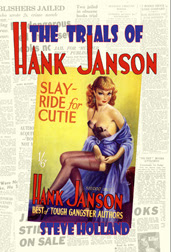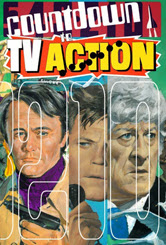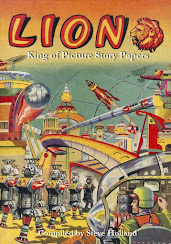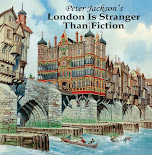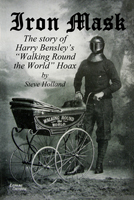So, here for your Hallowe'en pleasure, is the first ever episode. Enjoy...


 (* Cursitor Doom © IPC Media.)
(* Cursitor Doom © IPC Media.)





 (* Cursitor Doom © IPC Media.)
(* Cursitor Doom © IPC Media.)
 Not much to report on the work front. I've spent all week putting together a dummy for a possible book. After a couple of false starts it has now just about come together and I should have it wrapped up tomorrow (Friday). Good news, 'cos that's the deadline for it!
Not much to report on the work front. I've spent all week putting together a dummy for a possible book. After a couple of false starts it has now just about come together and I should have it wrapped up tomorrow (Friday). Good news, 'cos that's the deadline for it! I've a couple of updates for items published recently: remember Patti? She was the replacement for Jane in the Daily Mirror back in 1959. Well, Franco Giacomini kindly sent me another panel from the strip (see above) which mystery artist Bob Hamilton signed and guess what—his name's not Bob Hamilton. The error seems to date back to Denis Gifford's book on British newspaper strips, Stap Me!, published back in 1971. That's where the panel I previously published came from.
I've a couple of updates for items published recently: remember Patti? She was the replacement for Jane in the Daily Mirror back in 1959. Well, Franco Giacomini kindly sent me another panel from the strip (see above) which mystery artist Bob Hamilton signed and guess what—his name's not Bob Hamilton. The error seems to date back to Denis Gifford's book on British newspaper strips, Stap Me!, published back in 1971. That's where the panel I previously published came from. Another update: Jane, Daughter of Jane. Thanks to Rich Thomassen, I can now offer you a checklist of stories, although they add almost nothing to our knowledge of what the strips were about because none of the stories had a title.
Another update: Jane, Daughter of Jane. Thanks to Rich Thomassen, I can now offer you a checklist of stories, although they add almost nothing to our knowledge of what the strips were about because none of the stories had a title.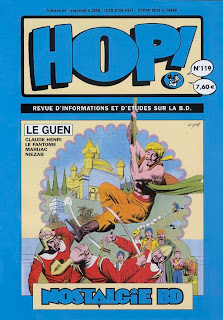 While we're on the subject of Europe (oh yes we were), the latest issue of Hop! has just landed on my doorstep. It's a French comics' fanzine, much admired. The latest issue is #119 which contains an interview with Pierre Le Guen, plus an extensive bibliography, and features on Gaston Niezab and Claude Henri, also with extensive bibliographies, a dossier on 'The Phantom', a look at some strips that appeared in Coq Hardi and a strip called 'Le Fantome Vert' by Fergal, who was featured in an earlier issue.
While we're on the subject of Europe (oh yes we were), the latest issue of Hop! has just landed on my doorstep. It's a French comics' fanzine, much admired. The latest issue is #119 which contains an interview with Pierre Le Guen, plus an extensive bibliography, and features on Gaston Niezab and Claude Henri, also with extensive bibliographies, a dossier on 'The Phantom', a look at some strips that appeared in Coq Hardi and a strip called 'Le Fantome Vert' by Fergal, who was featured in an earlier issue.
 Peter Gray reports that Ken Hunter, prolific contributor to D. C. Thomson's humour comics from the early 1950s until the late 1980s, died on Monday, 20 October, at the age of 91.
Peter Gray reports that Ken Hunter, prolific contributor to D. C. Thomson's humour comics from the early 1950s until the late 1980s, died on Monday, 20 October, at the age of 91. 'Mick on the Moon' (Beezer, 1956-57) was the first in a long line of science fiction adventures which also included the adventures of Jeff and Bill Star in the kingdom of Zero (Topper, 1957-61), 'The Survivors' (Beezer, 1959) and Professor 'Potassium' Roberts and youngster Nobby Clark (Beezer, 1960-65) as they battled Dr. Q and the Jellymen.
'Mick on the Moon' (Beezer, 1956-57) was the first in a long line of science fiction adventures which also included the adventures of Jeff and Bill Star in the kingdom of Zero (Topper, 1957-61), 'The Survivors' (Beezer, 1959) and Professor 'Potassium' Roberts and youngster Nobby Clark (Beezer, 1960-65) as they battled Dr. Q and the Jellymen.

 (* One-Eyed Jack © IPC Media.)
(* One-Eyed Jack © IPC Media.)
 Dorothy Hartley is known today as the writer of Food in England (1954), which is still in print and is regarded as a classic of cookery history, but she also wrote and illustrated a number of other books about the traditional working life of Britain before the second World War.
Dorothy Hartley is known today as the writer of Food in England (1954), which is still in print and is regarded as a classic of cookery history, but she also wrote and illustrated a number of other books about the traditional working life of Britain before the second World War. Life and Work of the Peoples of England covered the time from the Conquest to the eighteenth century, and comprised illustrations from contemporary manuscripts, drawings and prints. The object of the series was to give a view of the social life of each century through the eyes of the people who lived in it. The writers tried to select records suitable for general and school use, which has meant examining some thousands of MSS., prints, drawings and reference books. They were not children’s books as such but were compiled with an educative purpose. Hector Bolitho noted that teachers were not drawn to them but preferred the Quennells’ books, as “they preferred their stuff predigested.”
Life and Work of the Peoples of England covered the time from the Conquest to the eighteenth century, and comprised illustrations from contemporary manuscripts, drawings and prints. The object of the series was to give a view of the social life of each century through the eyes of the people who lived in it. The writers tried to select records suitable for general and school use, which has meant examining some thousands of MSS., prints, drawings and reference books. They were not children’s books as such but were compiled with an educative purpose. Hector Bolitho noted that teachers were not drawn to them but preferred the Quennells’ books, as “they preferred their stuff predigested.” From this time she wrote and illustrated a succession of books about the working life of the countryside and the small town. Thomas Tusser, his Good Points of Husbandry, 1931, Here’s England, 1934, Countryman’s England,1935, Made in England, 1939, Irish Holiday, 1938, Food in England, 1954, Water in England, 1964, The Land of England, 1979, and Lost Country Life, 1979.
From this time she wrote and illustrated a succession of books about the working life of the countryside and the small town. Thomas Tusser, his Good Points of Husbandry, 1931, Here’s England, 1934, Countryman’s England,1935, Made in England, 1939, Irish Holiday, 1938, Food in England, 1954, Water in England, 1964, The Land of England, 1979, and Lost Country Life, 1979. Her mother’s family were property owners at Fron House, Frontcysylltau near Llangollen, north Wales and, in 1933, she made a cottage on the estate her base. After the Second World War she rented Fron House out and the tenants ran a B & B there. She worked from Frontcysylltau for the rest of her life and died on 22 October 1985. Her ashes were interred in the family grave at St David's Church, Froncysylltau. Her photographic collection and other papers (including a set of cuttings of her Daily Sketch work) were willed to the Museum of Rural Life at Reading, where a printed catalogue of them is available for consultation.
Her mother’s family were property owners at Fron House, Frontcysylltau near Llangollen, north Wales and, in 1933, she made a cottage on the estate her base. After the Second World War she rented Fron House out and the tenants ran a B & B there. She worked from Frontcysylltau for the rest of her life and died on 22 October 1985. Her ashes were interred in the family grave at St David's Church, Froncysylltau. Her photographic collection and other papers (including a set of cuttings of her Daily Sketch work) were willed to the Museum of Rural Life at Reading, where a printed catalogue of them is available for consultation. PUBLICATIONS
PUBLICATIONS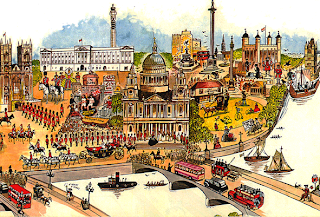 Les Barton, cartoonist and comic strip artist, died on 20 October 2008 at Hayes Cottage Nursing Home, not far from his home town of Uxbridge, Middlesex, after a long illness.
Les Barton, cartoonist and comic strip artist, died on 20 October 2008 at Hayes Cottage Nursing Home, not far from his home town of Uxbridge, Middlesex, after a long illness. His first comic strips appeared in The Evil Eye Thriller shortly after the war, Barton drawing two issues of the 8-page comic for Bernard Kaye in 1947; he also drew occasional filler strips for 'Billy Bunter' in Knockout when Frank Minnitt was indisposed. Barton returned to comics in the late 1960s with 'I Spy' in Sparky and maintained a steady output of strip throughout the 1970s, including 'Harriet and Her Horse' (Cor!!), 'Ma Kelly's Telly' (Sparky), 'Knight School' (Whizzer & Chips), 'Phone the Crows' and 'Autotech' (both Topper). As 'Lezz' (with which name he had often signed his early cartoons) he also drew a strip about the punk band 'The Slugs' for Oink.
His first comic strips appeared in The Evil Eye Thriller shortly after the war, Barton drawing two issues of the 8-page comic for Bernard Kaye in 1947; he also drew occasional filler strips for 'Billy Bunter' in Knockout when Frank Minnitt was indisposed. Barton returned to comics in the late 1960s with 'I Spy' in Sparky and maintained a steady output of strip throughout the 1970s, including 'Harriet and Her Horse' (Cor!!), 'Ma Kelly's Telly' (Sparky), 'Knight School' (Whizzer & Chips), 'Phone the Crows' and 'Autotech' (both Topper). As 'Lezz' (with which name he had often signed his early cartoons) he also drew a strip about the punk band 'The Slugs' for Oink. This one brings back some memories. This is 120 pages of solid Roy of the Rovers footballing goodness drawn from the old Roy of the Rovers Annual with a few contemporary adverts from the pages of Tiger thrown in to give it that authentic 1950s/1960s feel—deliberately pandering to the nostalgia of middle-aged blokes who remember tearing at wrapping paper to get to the annuals we used to get every Christmas as kids. Not the thin things you get nowadays that masquerade as annuals but large hunks of books that would take you until New Year to read all the way through.
This one brings back some memories. This is 120 pages of solid Roy of the Rovers footballing goodness drawn from the old Roy of the Rovers Annual with a few contemporary adverts from the pages of Tiger thrown in to give it that authentic 1950s/1960s feel—deliberately pandering to the nostalgia of middle-aged blokes who remember tearing at wrapping paper to get to the annuals we used to get every Christmas as kids. Not the thin things you get nowadays that masquerade as annuals but large hunks of books that would take you until New Year to read all the way through. Following on from yesterday's post about Jane, here's a checklist of stories featuring Patti, the strip that replaced Jane in the Daily Mirror in 1959. I know very little about the strip other than that it featured the titular character, a teenager who was probably thought to be more to the liking of a 'modern' (1959) audience than Jane, whose heyday was probably considered to be the 1930s and 1940s.
Following on from yesterday's post about Jane, here's a checklist of stories featuring Patti, the strip that replaced Jane in the Daily Mirror in 1959. I know very little about the strip other than that it featured the titular character, a teenager who was probably thought to be more to the liking of a 'modern' (1959) audience than Jane, whose heyday was probably considered to be the 1930s and 1940s. Just ahead of the appearance of a new book featuring the famous Jane strip from the Daily Mirror, I thought I'd attempt a checklist of stories. Franco Giacomini kindly sent me a list of strips that had appeared in the Italian paper Il Giorno, along with the codes as used on various Daily Mirror strips. To this I've added those titles I've been able to gather from other sources. Where I don't have the original English titles I've retained Franco's titles from his Italian listing.
Just ahead of the appearance of a new book featuring the famous Jane strip from the Daily Mirror, I thought I'd attempt a checklist of stories. Franco Giacomini kindly sent me a list of strips that had appeared in the Italian paper Il Giorno, along with the codes as used on various Daily Mirror strips. To this I've added those titles I've been able to gather from other sources. Where I don't have the original English titles I've retained Franco's titles from his Italian listing. X
X Jane, Daughter of Jane
Jane, Daughter of Jane Jane Eyre is one of a clutch of new titles that have come out from Classical Comics recently, the other two being Frankenstein and A Christmas Carol. Of the three, this was the one I was looking forward to the most, solely for the artwork by John M. Burns, possibly the finest comics artist working in the UK at the moment. Burns has been drawing comic strips professionally for fifty years and worked on everything from Modesty Blaise to Judge Dredd in that time. He brings to Jane Eyre the experience of someone who has drawn historical strips before (including, many years ago, adaptations of Wuthering Heights and Lorna Doone) and the skill to depict one of the essential ingredients of the story—Jane growing from a child of nine to a young woman of nineteen.
Jane Eyre is one of a clutch of new titles that have come out from Classical Comics recently, the other two being Frankenstein and A Christmas Carol. Of the three, this was the one I was looking forward to the most, solely for the artwork by John M. Burns, possibly the finest comics artist working in the UK at the moment. Burns has been drawing comic strips professionally for fifty years and worked on everything from Modesty Blaise to Judge Dredd in that time. He brings to Jane Eyre the experience of someone who has drawn historical strips before (including, many years ago, adaptations of Wuthering Heights and Lorna Doone) and the skill to depict one of the essential ingredients of the story—Jane growing from a child of nine to a young woman of nineteen. Although the language is that used by Charlotte Bronte (the descriptions are abridged but the dialogue and captions are all from the original novel), there is no room for mistaking what the characters are saying or thinking thanks to the illustrations. The images bring the story to life with delightful clarity. You begin to notice things in the story that you might otherwise have missed. To take one little for instance: the book's metaphor of birds. "Birds were emblems of love," says Jane (p.91) and birds are a recurring motif of how Rochester imagines her, comparing her to a nonnette and a linnet; he imagines Jane will "come with soft flight and nestle against my heart." Burns draws each in the thoughts of the man as he speaks. Birds continue to feature throughout: when Jane runs away she is helped by sisters Diana and Mary "as they would a half-frozen bird"; at Ferndean, Mr Rochester is a "caged eagle"; his hair reminds Jane of an eagle's feathers and his "nails are grown like birds' claws"; and, lastly, Rochester compares her to a skylark and Jane decides that their relationship is "just as if a royal eagle, chained to a perch, must entreat a sparrow to become its purveyor." I wonder how many would spot this quite so easily had the artwork not made it so obvious in some of the frames.
Although the language is that used by Charlotte Bronte (the descriptions are abridged but the dialogue and captions are all from the original novel), there is no room for mistaking what the characters are saying or thinking thanks to the illustrations. The images bring the story to life with delightful clarity. You begin to notice things in the story that you might otherwise have missed. To take one little for instance: the book's metaphor of birds. "Birds were emblems of love," says Jane (p.91) and birds are a recurring motif of how Rochester imagines her, comparing her to a nonnette and a linnet; he imagines Jane will "come with soft flight and nestle against my heart." Burns draws each in the thoughts of the man as he speaks. Birds continue to feature throughout: when Jane runs away she is helped by sisters Diana and Mary "as they would a half-frozen bird"; at Ferndean, Mr Rochester is a "caged eagle"; his hair reminds Jane of an eagle's feathers and his "nails are grown like birds' claws"; and, lastly, Rochester compares her to a skylark and Jane decides that their relationship is "just as if a royal eagle, chained to a perch, must entreat a sparrow to become its purveyor." I wonder how many would spot this quite so easily had the artwork not made it so obvious in some of the frames. Artistically, Jane Eyre is nothing short of superb and the book is an unexpected delight as poor Jane suffers one dreadful torment after another before she and her true love can finally be together. Classical Comics should be applauded for their efforts (indeed, they have been, with an IPPY award last May). The series is tied closely to the school curriculum, hence the concentration of Shakespeare, Dickens and other classics. They're good hunks of books, too, Jane Eyre running to 125 pages plus 8 pages of background material. If Jane Eyre is not your cup of tea, give one of the others a try: A Christmas Carol is a Dickens' classic with ghosts and artwork by Mike Collins & David Roach; Frankenstein adapts Mary Shelley's monster-fest with art by Declan Shalvey. There should be something for most tastes and if your tastes don't run to the original text, there's always the 'quick text' adaptations which modernise the language without losing any of the story elements.
Artistically, Jane Eyre is nothing short of superb and the book is an unexpected delight as poor Jane suffers one dreadful torment after another before she and her true love can finally be together. Classical Comics should be applauded for their efforts (indeed, they have been, with an IPPY award last May). The series is tied closely to the school curriculum, hence the concentration of Shakespeare, Dickens and other classics. They're good hunks of books, too, Jane Eyre running to 125 pages plus 8 pages of background material. If Jane Eyre is not your cup of tea, give one of the others a try: A Christmas Carol is a Dickens' classic with ghosts and artwork by Mike Collins & David Roach; Frankenstein adapts Mary Shelley's monster-fest with art by Declan Shalvey. There should be something for most tastes and if your tastes don't run to the original text, there's always the 'quick text' adaptations which modernise the language without losing any of the story elements. Sad to hear that Barrington Bayley, died on Tuesday, 14 October 2008, from complications following bowel cancer, at the age of 71. Barry Bayley was born in Birmingham on 9 April 1937, the son of John Bayley (a toolmaker) and his wife Clarissa Mary (nee Love). Aged around 8, the Bayley family moved to Shropshire where Barry attended Adams Grammar School.
Sad to hear that Barrington Bayley, died on Tuesday, 14 October 2008, from complications following bowel cancer, at the age of 71. Barry Bayley was born in Birmingham on 9 April 1937, the son of John Bayley (a toolmaker) and his wife Clarissa Mary (nee Love). Aged around 8, the Bayley family moved to Shropshire where Barry attended Adams Grammar School.I should note that Amazon update their charts hourly so there can be dramatic changes over the course of a day.TOP 27 ANNUALS
1. High School Musical Annual 2009. Egmont (ISBN 978-1405239042), 4 Aug 2008.
2. The Beano Annual 2009. D. C. Thomson (ISBN 978-1845353490), 3 Sep 2008.
3. Top Gear Annual 2009. Penguin (ISBN 978-1405904551), 7 Aug 2008.
4. Doctor Who. The Official Annual 2009. Penguin (ISBN 978-1405904278), 7 Aug 2008.
5. Hannah Montana Annual 2009. Egmont (ISBN 978-1405242929), 30 Oct 2008. But out now.
6. Ben 10 Annual 2009. Egmont (ISBN 978-1405239097), 4 Aug 2008.
7. The Dandy Annual 2009. D. C. Thomson (ISBN 978-1845353483), 3 Sep 2008.
8. Peppa Pig. The Official Annual 2009. Ladybird Books (ISBN 978-1846469565), 30 Oct 2008. But out now.
9. Dennis the Menace and Gnasher Annual 2009. D. C. Thomson (ISBN 978-1845353537), 3 Sep 2008.
10. Disney Princess Annual 2009. Egmont (ISBN 978-1405239059), 4 Aug 2008.
11. SpongeBob Squarepants Annual 2009. Egmont (ISBN 978-1405239073), 4 Aug 2008.
12. The Rupert Bear Annual [2009]. Egmont (ISBN 978-1405238908), 4 Aug 2008.
13. The Bash Street Kids: Space Cadets. D. C. Thomson (ISBN 978-1845353520), 3 Sep 2008.
14. Thomas & Friends Annual 2009. Egmont (ISBN 978-1405239134), 4 Aug 2008.
15. My Extremely Good Charlie and Lola Annual 2009. Puffin Books (ISBN 978-0141384030), 7 Aug 2008.
16. Dora the Explorer Annual 2009. Egmont (ISBN 978-1405239127), 30 Oct 2008. But out now.
17. Bunty for Girls 2009. D. C. Thomson (ISBN 978-1845353506), 3 Sep 2008.
18. Rupert [1963 Facsimile]. Egmont (ISBN 978-1405241120), 4 Aug 2008.
19. Lazy Town Annual 2009. Egmont (ISBN 978-1405239066), 4 Aug 2008.
20. In the Night Garden Annual 2009. Penguin (ISBN 978-1405904704), 7 Aug 2008.
21. Brownie Annual 2009. The Guide Association (ISBN 978-0852602423), Aug 2008.
22. Animals and You Annual 2009. D. C. Thomson (ISBN 978-1845353513), 3 Sep 2008.
23. Power Rangers Annual 2009: Operation Overdrive. Egmont (ISBN 978-1405239028), 4 Aug 2008.
24. Bob the Builder Annual 2009. Egmont (ISBN 978-1405239158), 4 Aug 2008.
25. Rainbow Magic Annual 2009. Orchard (ISBN 978-1408302729), 7 Aug 2008.
26. Disney-Pixar: The World of Cars Annual 2009. Egmont (ISBN 978-1405239035), 4 Aug 2008.
27. Shaun the Sheep Annual 2009. Egmont (ISBN 978-1405239172), 4 Aug 2008.TOP 12 OTHERS
1. Beano and Dandy: Comics in the Classroom. D. C. Thomson (ISBN 978-1845353476), 3 Sep 2008.
2. Charley's War: Return to the Front. Titan Books (ISBN 978-1845767969), 24 October 2008. But out now.
3. Commando: Bandits at 12 O'clock, edited by George Low. Carlton Books (ISBN 978-1847321282), 1 September 2008.
4. Artemis Fowl: The Graphic Novel, by Eoin Colfer and Andrew Donkin & Giovanni Rigano. Puffin Books (ISBN 978-0141322964), 4 Oct 2007.
5. Judge Dredd: The Complete Case Files Vol.11 by various. Rebellion (ISBN 978-1905437795), 9 October 2008.
6. The Best of Roy of the Rovers: The 1980s. Titan Books (ISBN 978-1845769482) 13 Jun 2008.
7. Silverfin: The Graphic Novel [Young James Bond], by Charlie Higson & Kev Walker. Puffin Books (ISBN 978-0141322537), 2 Oct 2008.
8. The Best of 2000AD. Prion Books (ISBN 978-1853756689), 1 September 2008.
9. Battle Picture Library: Let 'em Have It, edited by Steve Holland. Prion Books (ISBN 978-1853756719) 6 October 2008.
10. Commando Ammo Box. Carlton Books (ISBN 978-1847320872), 6 October 2008.
11. Alice in Sunderland, by Bryan Talbot. Jonathan Cape (ISBN 978-0224080767), 5 Apr 2007.
12. The Cream of Tank Girl by Alan C. Martin & Jamie Hewlett. Titan Books (ISBN 978-1845769420), 24 October 2008.
